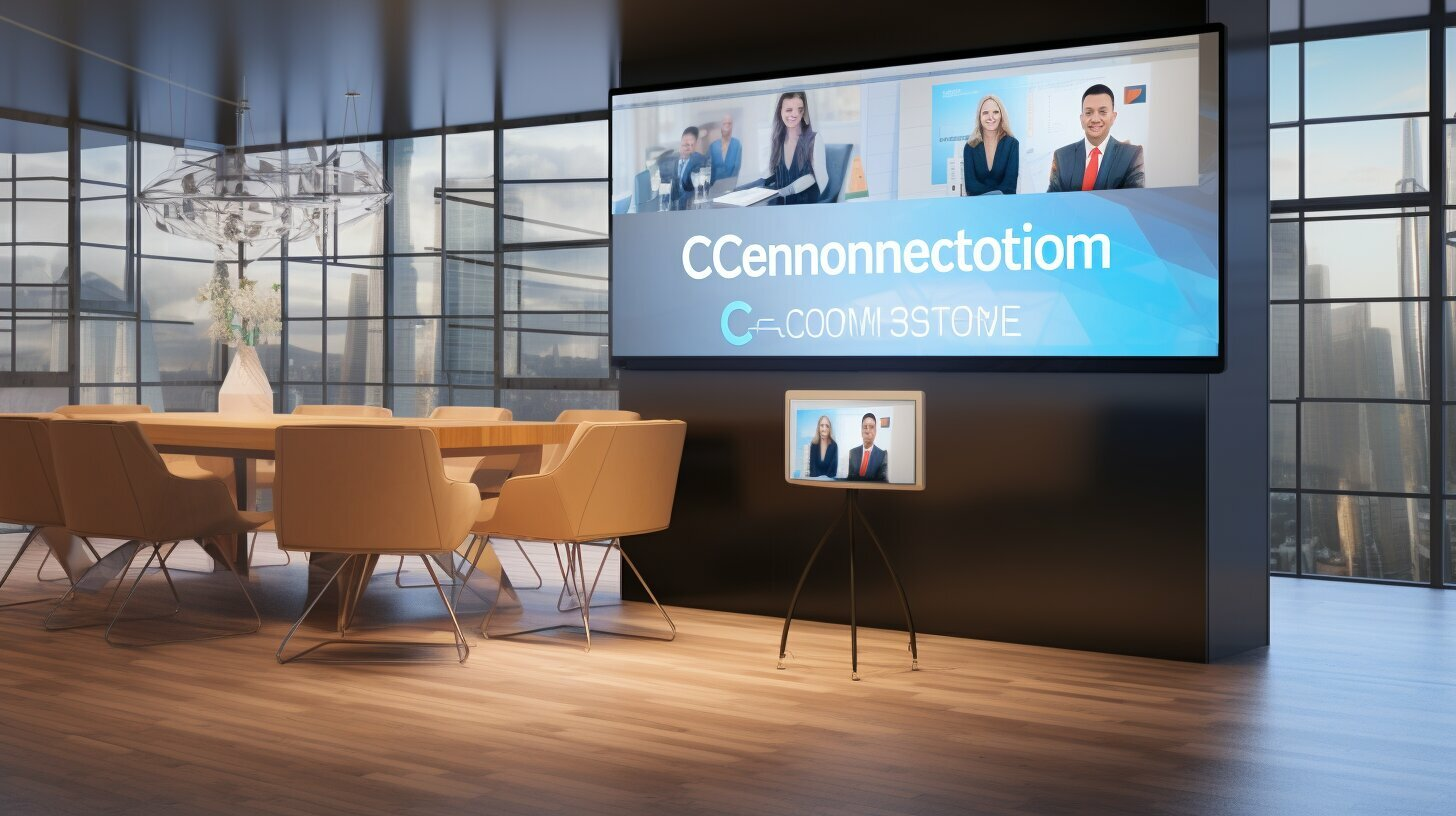
Video conferencing has become an integral part of modern communication and collaboration. It has revolutionized how we interact with colleagues, clients, and customers across different locations. The video conferencing industry has witnessed significant advancements in recent years, and this trend is expected to continue.
The future of video conferencing in 2023 looks promising as technology continues to evolve and more organizations adopt remote work. The demand for video conferencing solutions is expected to increase, and the industry is projected to grow significantly.
Key Takeaways:
- The conferencing industry is expected to witness significant growth in the future.
- Technology advancements will continue to enhance the video conferencing experience.
- Remote work will drive the demand for conferencing solutions.
The Evolution of Video Conferencing Technology
Over the years, conferencing technology has evolved significantly, enabling users to communicate and collaborate efficiently. One of the notable advancements in conferencing technology is the improvement in video and audio quality, leading to more lifelike conversations. Today, conferencing technology is a vital communication tool for businesses, government agencies, educational institutions, and individuals worldwide.
The development of conferencing software has played a significant role in the evolution of video conferencing technology. Conferencing software enables multiple users to join a video conference from various locations and devices, eliminating the need for physical meetings. Additionally, video conferencing software allows users to share files, access virtual whiteboards, and collaborate in real-time.
The integration of audio conferencing capabilities has also impacted the evolution of conferencing technology. Audio conferencing allows users to join a video conference using a phone or a computer audio system. This feature is particularly useful in remote working environments where participants cannot access a camera or a stable internet connection.

The Future of Video Conferencing Technology
The future of conferencing technology looks promising, with several advancements expected in the coming years. For instance, we can expect improved video call quality, thanks to the rise in video compression technology and augmented reality integration to enhance the conferencing experience.
Additionally, we can expect to use Artificial Intelligence to enable virtual assistants to conduct video conferences and provide real-time translation services.
The video conferencing industry is constantly evolving, and with the increasing demand for remote work, it is expected to continue growing in the coming years.
Conferencing technology will also see the emergence of new players in the industry, such as Adobe Systems, Cisco Systems, and Google Meet. These players will introduce new features and capabilities to the market, increasing competition and innovation.
In conclusion, conferencing technology’s evolution has significantly impacted how we communicate and collaborate. The advancements in video and audio quality, the development of video conferencing software, and the integration of audio conferencing capabilities have all contributed to the growth of video conferencing as a vital communication tool.
With the future of video conferencing looking bright, we can expect more innovative solutions to enhance the experience.
Video Conferencing Platforms: Trends and Features
Video conferencing platforms have become essential for communication and collaboration, especially in today’s remote work environment. With so many options available, choosing the right video conferencing app that meets your needs is important. This section will explore the latest trends and features in video conferencing platforms.
Virtual Reality Integration
Virtual reality is emerging as a powerful tool for immersive conferencing experiences. Some video conferencing apps are starting to integrate virtual reality, creating a more engaging and interactive environment for participants.
With virtual reality, users can feel like they are in the same physical space, enhancing collaboration and communication.
Screen Sharing Capabilities
Screen sharing is a key feature of many conferencing platforms. It allows participants to share their screens with others, making it easier to collaborate and work together on projects. Some platforms have advanced screen-sharing capabilities, such as annotating or drawing on the shared screen in real-time.
Mobile Apps
With the rise of remote work, mobile apps have become essential to video conferencing solutions. Many conferencing platforms offer mobile apps that allow users to join meetings and collaborate on the go. Mobile apps often have functionality similar to desktop apps, making working seamlessly across mobile devices easier.
High-Quality Audio and Video
Video and audio quality are crucial to a successful conferencing experience. Many video conferencing apps have improved audio and video quality, making it feel like you are in the same room as the other participants. High-quality audio and video also reduce distractions and improve communication during the meeting.

Overall, the latest trends and features in conferencing platforms make collaborating and communicating easier, no matter where you are. Virtual reality integration, screen sharing capabilities, mobile apps, and high-quality audio and video are key features for choosing a video conferencing app that suits your needs.
The Rise of Video Conferencing in Remote Work
Remote work has become increasingly prevalent in recent years, and the COVID-19 pandemic accelerated the shift towards a more remote workforce. Effective communication and collaboration have become essential with more employees working from home. Conferencing has emerged as a vital tool for remote teams to enable individuals to connect and work together seamlessly.
Productivity tools such as conferencing have enabled remote workers to stay productive and engaged, regardless of location. With video conferencing, remote workers can communicate effectively with team members, participate in meetings, and stay up-to-date with project progress, all in real-time.
Remote communication can be challenging, but conferencing has helped bridge the gap. It provides a visual element that audio conferencing cannot, enabling remote workers to see each other and improve overall communication. With conferencing, remote teams can collaborate more effectively and better understand each other’s personalities and work styles.
Moreover, conferencing has proven to be an effective tool for improving productivity and engagement among remote workers. According to a study by Owl Labs, companies that offer remote work options and use video conferencing tools have 25% lower employee turnover than those that do not.
Overall, conferencing has significantly impacted the rise of remote work and is crucial for creating a productive and collaborative remote team. As remote work continues to grow, it is clear that video conferencing will play a vital role in the future of work.

The Impact of Video Conferencing on Business Communication
Video conferencing has revolutionized the way businesses communicate. Conferencing solutions allow conference participants to connect and collaborate efficiently, regardless of location. It is a powerful tool that has transformed how companies operate and provided countless benefits in speed, efficiency, and productivity.
One of the significant advantages of conferencing is its ability to bring people together in a conference room, even if they are miles apart. This is especially useful for businesses with multiple offices or remote workers, where face-to-face meetings may not be possible. Conferencing has made it easy for companies to connect their teams and maintain effective communication.
| Benefits of Using Video Conferencing in Conference Rooms: |
|---|
| Easy to use interface: Modern conferencing platforms have an intuitive and user-friendly interface, so even non-technical users can participate in video meetings without any difficulty. |
| Cost-effective: Conferencing eliminates travel, saving businesses time and money. |
| Cost-effective: Conferencing eliminates the need for travel, saving businesses time and money. |
Moreover, conferencing has transformed meetings, making them more engaging and interactive. With the integration of advanced features like screen sharing, real-time chat, and collaborative whiteboards, video conferencing has made it easy to share ideas and work together on projects.
Business communication has never been more comfortable and efficient than it is with conferencing. By leveraging the benefits of conferencing and adopting the latest technologies, businesses can enhance their communication, productivity, and collaboration.

Enhancing Video Conferencing with Innovative Solutions
Conferencing has come a long way since its inception. With the rapid evolution of technology, innovative solutions have emerged to enhance the overall conferencing experience.
One of the most essential features of modern conferencing platforms is file sharing. Sharing files during a video call has become necessary for collaborating and streamlining workflows.
Sharing files such as documents, spreadsheets, and presentations during a video meeting ensures that all participants are on the same page, and it helps avoid any confusion or misunderstandings.
| Innovative Solutions | Description |
|---|---|
| High-quality audio | Collaboration tools like virtual whiteboards and real-time annotation features have made it easier than ever to work together during a video call. This enhances the overall experience and makes video meetings less like a chore. |
| Real-time collaboration tools | Collaboration tools like virtual whiteboards and real-time annotation features have made it easier than ever to work together during a video call. This enhances the overall experience and makes video meetings less like a chore. |
| Addressing audio delays | One of the biggest challenges in conferencing is audio delays that disrupt the flow of conversation. Innovative solutions are emerging that tackle this issue by using advanced algorithms to minimize delays and ensure that communication is seamless. |
Another significant enhancement in conferencing technology is the improvement in audio quality. Audio is a crucial component of effective communication, and it is essential that every participant can hear and be heard clearly. With advanced noise cancellation technology, crystal clear audio is now possible, even in noisy environments.
Lastly, real-time collaboration tools have become a game-changer for conferencing. Features like virtual whiteboards and real-time annotation enable participants to collaborate seamlessly during video calls. These tools enhance the overall experience and make video meetings less structured and more engaging.

With these innovative solutions, video conferencing has become more than just a way to communicate remotely. It’s an essential tool for businesses to collaborate, streamline workflows, and communicate effectively. As video conferencing continues to evolve, these innovations, along with others, will play a crucial role in shaping the future of remote communication.
The Growing Demand for Video Conferencing Services
Conferencing has become an increasingly popular solution for remote communication and collaboration. As a result, the conferencing market has experienced significant growth in recent years, and it is projected to expand in the coming years.
The conferencing market size was valued at $6.37 billion in 2019 and is expected to reach $11.56 billion by 2027, growing at a CAGR of 8.3% from 2020 to 2027. This growth can be attributed to the rising trend of remote work and the need for effective communication solutions.
The popularity of video meetings is also on the rise, with many organizations incorporating them into their daily operations. Video meetings enable remote teams to connect face-to-face, improving communication and collaboration and reducing the need for in-person meetings.
With the growing demand for video conferencing services, many providers offer innovative solutions and enhanced features to remain competitive. This has led to the emergence of various conferencing platforms and apps, each with its unique set of features and capabilities.

As remote work and virtual communication continue to become more prevalent, the demand for conferencing services is expected to rise further. Organizations must choose reliable and secure conferencing solutions that meet their unique needs and facilitate effective communication and collaboration.
The Future of Video Conferencing: Advancements and Predictions
Conferencing has come a long way since its inception, and it is poised to undergo further advancements in the coming years. With the rise of remote work and the increasing importance of virtual communication, video conferencing has become an essential tool for businesses and individuals.
The future of conferencing looks promising, with various players like Adobe Systems, Cisco Systems, and Google Meet leading the way with innovative solutions and features.
Improved Video Call Quality
One of the significant areas of focus for conferencing providers is improving the quality of video calls. While high-definition video is already the norm for many platforms, there is room for improvement regarding reducing lag and improving video and audio synchronization. Some providers are experimenting with new codecs and other technologies to enhance the conferencing experience.

Artificial Intelligence in Conferencing
Another area of excitement in the future of conferencing is using artificial intelligence (AI) to improve the user experience. AI-powered virtual assistants can help manage meetings, detect speaker changes, and automate tasks like taking notes or sending follow-up emails. As AI technology continues to improve, we can expect to see more sophisticated applications of AI in video conferencing solutions.
Emerging Players
As the conferencing industry expands, we expect more players to enter the market. Companies like Adobe Systems, Cisco Systems, and Google Meet are already making waves with their innovative features and robust solutions. These companies are investing heavily in research and development to stay ahead of the curve, and we can expect them to continue leading the way.
As you can see, the future of conferencing is bright. With continued advancements in technology, we can expect conferencing to become even more mainstream and integral to the daily operations of businesses and organizations. If you haven’t yet embraced video conferencing, now is the time to explore the various available solutions and providers.
Virtual Events: The Next Frontier in Video Conferencing
Virtual events have become increasingly popular in recent years, especially with the rise of remote working. Online events effectively allow organizations to reach a broader audience and connect with remote participants. With the help of conferencing and new technology, virtual events have become more interactive and engaging.
From business conferences to trade shows and webinars, virtual events enable you to participate from anywhere in the world. Remote working is now easier than ever, as you can attend events, engage with participants, and share information without being physically present.

Virtual events are also convenient and cost-effective. You don’t have to worry about travel expenses, accommodation, or other logistical arrangements. Additionally, virtual events allow you to meet and network with like-minded individuals worldwide.
However, virtual events do come with their own set of challenges. Technical difficulties, lack of face-to-face interaction, and poor internet connectivity can all impact the quality of the experience. As more organizations move towards virtual events, finding reliable and secure conferencing solutions that can handle large numbers of participants is important.
The Importance of Enhanced Security and Privacy in Video Conferencing
As conferencing continues to rise, it is essential to prioritize the security and privacy of conference participants. With sensitive conversations taking place over video calls, choosing secure and reliable conferencing solutions is critical to protect against potential security breaches and data leaks. One such solution is Cisco Systems Inc.
Cisco Systems Inc. provides a comprehensive range of conferencing solutions prioritizing security and privacy. Their answers offer end-to-end encryption, secure access controls, and built-in multi-factor authentication, ensuring only authorized users can access your video calls.
Additionally, Cisco Systems Inc. offers advanced security features such as encrypted recording and secure file sharing, providing an all-around secure conferencing experience.
When selecting a conferencing solution, it’s essential to prioritize enhanced security and privacy. With Cisco Systems Inc., you can rest assured that your video conferences are secure, protecting you and your conference participants from potential security threats.

The Conclusion: Making the Most of Video Conferencing in the Future
Conferencing has become an indispensable tool for communication and collaboration in today’s fast-paced world. With advancements in technology, innovation, and integration, it is no surprise that the future of video conferencing looks bright.
In this article, we explored the key insights into the future of conferencing in 2023, including the evolution of conferencing technology, emerging trends and features of conferencing platforms, the impact of video conferencing on remote work and business communication, and emerging solutions for enhancing the conferencing experience.
The Future of Video Conferencing: Advancements and Predictions
As we look ahead, the future of conferencing appears exciting. Advancements such as improved video call quality, increasing use, widespread adoption of artificial intelligence, and emerging players in the industry, such as Adobe Systems, Cisco Systems, and Google Meet, suggest significant growth and competition. Keeping up with these advancements will be integral to succeed in the video conferencing space.
Virtual Events: The Next Frontier in Video Conferencing
Virtual events and online meetings have become increasingly popular due to conferencing technology’s convenience. They offer the possibility of hosting conferences, webinars, and meetings catering to remote participants and enhancing collaboration capabilities. Virtual events present several benefits, but some challenges come along with them, such as technical difficulties and participant engagement.
Security and Privacy in Video Conferencing
Security and privacy are essential concerns in conferencing. As remote work becomes more common, the risks associated with data breaches and hacking attacks increase. In response, conferencing platforms and providers are implementing enhanced security measures to safeguard their clients’ privacy and data.
Cisco Systems has positioned itself as a leader, creating several secure conferencing technologies and solutions suitable for various industries.
In conclusion, conferencing will play an increasingly important role in communication, business travel, and collaboration – staying updated with technological advancements and trends is essential to take full advantage of its benefits. The future of video conferencing is bright, and it’s time to embrace its possibilities fully.
Experience the TEXMG Difference – Your Trusted IT Partner for a Brighter Future!
Are you ready to embrace the future of conferencing and IT services? Look no further than Texas Management Group (TEXMG), where cutting-edge technology meets unparalleled expertise.
Why TEXMG Stands Out:
Unmatched Expertise: Our highly knowledgeable and experienced IT professionals have been at the forefront of the industry for nearly a decade. With TEXMG, you’re partnering with the best in the business.
Serving Businesses Like Yours: TEXMG has been providing top-notch IT services tailored for small and medium-sized businesses for years. We understand your unique needs and challenges, and we’re here to help you succeed.
Affordable Excellence: We’re committed to offering the most competitive rates for IT services in the entire state of Texas. Quality IT solutions don’t have to come with a hefty price tag, and we’re proof of that.
Staying Ahead of the Curve: Technology is constantly evolving, and we’re always one step ahead. Our experts are continuously learning and adapting to bring you the latest innovations and solutions.
Comprehensive Support: TEXMG provides end-to-end professional services, from solution selection and installation to training and ongoing support. We’re your trusted partner every step of the way.
Experience the TEXMG difference, where excellence is not just a promise but a way of life.
Contact us today to explore how TEXMG can transform your business’s IT landscape and make the future brighter than ever! Join the ranks of satisfied clients who’ve seen their businesses soar with TEXMG.
Contact TEXMG Now and Unlock the Full Potential of Your IT Infrastructure!
FAQ
Q: What is video conferencing?
A: Conferencing is a communication technology that allows individuals or groups to meet and collaborate remotely through video and audio connections. It enables face-to-face interactions, regardless of the geographical location of the participants.
Q: What are the benefits of video conferencing?
A: Conferencing offers several benefits, including improved communication and collaboration, cost savings on travel expenses, increased productivity and efficiency, and the ability to connect remote teams seamlessly.
Q: What are the different video conferencing platforms available?
A: There are various video conferencing platforms available in the market, such as Zoom, Microsoft Teams, Google Meet, and Cisco Webex. These platforms offer different features and functionalities to cater to diverse communication needs.
Q: How can conferencing enhance remote work?
A: Conferencing enables effective communication and collaboration among remote teams. It facilitates virtual meetings, screen sharing, and real-time interactions, fostering a sense of connection and teamwork despite physical distance.
Q: What should I consider when choosing a video conferencing solution?
A: When choosing a conferencing solution, consider factors such as ease of use, audio and video quality, security features, compatibility with your devices and operating systems, and the number of participants supported.
Q: Are video conferencing calls secure?
A: Video conferencing providers take measures to ensure enhanced security and protect the privacy of conference participants. Choosing a reliable and secure video conferencing solution, such as Cisco Systems Inc., is important to ensure the confidentiality and integrity of your own video teleconferencing conferences.
Q: What is the future of video conferencing?
A: The future of conferencing holds advancements such as improved video call quality, the incorporation of artificial intelligence, and emerging players in the industry like Adobe Systems, Cisco Systems, and Google Meet. The possibilities for enhanced communication and collaboration are vast.
Q: Can video conferencing be used for virtual events?
A: Yes, conferencing technology has made it possible to host virtual events, conferences, and webinars. It allows remote participants to join and engage with the event, expanding the reach and accessibility of such gatherings.
Q: How can video conferencing contribute to business communication?
A: Video conferencing has revolutionized business communication by facilitating seamless collaboration in conference rooms, providing an easy-to-use interface, and connecting participants from different locations. It has transformed meetings and enhanced communication within organizations.
Q: What are some innovative solutions in video conferencing?
A: Some innovative video conferencing trends include features like file sharing, high-quality audio, and real-time collaboration tools. These solutions aim to enhance video conferencing experience and address common challenges such as audio delays.